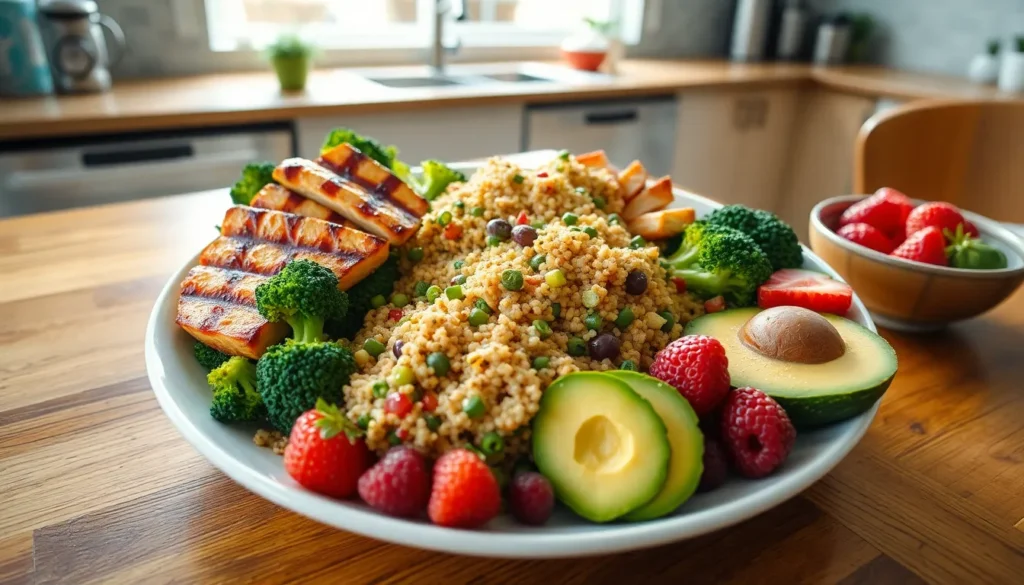Eating well doesn’t have to be complicated. A balanced plate is a simple yet effective way to ensure that meals provide the essential nutrients needed for a healthy lifestyle. By understanding how to create a balanced plate, individuals can make informed choices that support their overall well-being and energy levels.
This guide breaks down the components of a balanced plate, highlighting the right proportions of proteins, carbohydrates, and fats. With practical tips and easy-to-follow strategies, anyone can transform their meals into nourishing experiences. Whether you’re looking to improve your diet or simply maintain a healthy lifestyle, mastering the art of the balanced plate is a crucial step toward achieving those goals.
Table of Contents
ToggleWhat Is a Balanced Plate Guide?
A balanced plate guide serves as a practical tool for ensuring meals are nutritionally adequate. It delineates the ideal proportions of food groups that contribute to overall health. The balanced plate often includes:
- Proteins: Aim for about ¼ of the plate, focusing on lean options like chicken, fish, beans, and nuts. Proteins provide essential amino acids for muscle repair and growth.
- Carbohydrates: Allocate roughly ½ of the plate to carbohydrates, emphasizing whole grains, fruits, and vegetables. These foods deliver necessary energy, fiber, and vitamins for bodily functions.
- Fats: Reserve approximately ¼ of the plate for healthy fats. Include sources such as avocados, olive oil, and fatty fish, which support heart health and nutrient absorption.
The guide encourages individuals to select a variety of colors and types of foods. Incorporating a diversity of vegetables and whole grains enhances nutrient intake and meal satisfaction. By following the balanced plate guide, individuals simplify meal preparation while promoting a healthier lifestyle.
Benefits of Following a Balanced Plate Guide

A balanced plate enhances overall health by ensuring adequate nutrient intake. It promotes a sustainable approach to eating, leading to various benefits.
Improved Nutrition
Improved nutrition results from consuming a diverse range of food. A balanced plate includes various food groups, which provide essential vitamins and minerals. Incorporating colorful vegetables, whole grains, and lean proteins ensures adequate fiber and antioxidants. For example, a meal featuring broccoli, quinoa, and grilled salmon satisfies nutritional needs while enhancing overall health. Studies show that individuals who focus on balanced meals often experience an increase in energy levels and improved immune function.
Weight Management
Weight management becomes more manageable with a balanced plate approach. Proper portion sizes prevent overeating and ensure calorie control. By filling half the plate with vegetables and whole grains, individuals stay fuller for longer, reducing the likelihood of excessive snacking. Research indicates that people who follow balanced plate guidelines maintain healthier weights compared to those who do not. By emphasizing nutrient-dense foods over calorie-dense options, the balanced plate guide supports sustainable weight loss and helps prevent obesity-related health issues.
How to Create Your Own Balanced Plate
Creating a balanced plate involves selecting appropriate food types and managing portion sizes effectively. Following specific guidelines ensures meals are nutritionally rich and satisfying.
Portion Control
Portion control focuses on managing the amount of food consumed at each meal. Individuals should consider using smaller plates to help regulate serving sizes. Dividing the plate into sections aids in visualizing recommended proportions: one-quarter for lean proteins, one-half for carbohydrates, and one-quarter for healthy fats. Tracking intake with measuring cups or a food scale enhances accuracy and awareness, reducing the likelihood of overeating. Regularly monitoring portions fosters better eating habits and supports overall health.
Food Groups to Include
Incorporating a variety of food groups is essential for a balanced plate. The main groups include:
- Proteins: Lean meats, poultry, fish, legumes, and tofu provide necessary amino acids. Aim for 3 to 4 ounces per serving.
- Carbohydrates: Whole grains like brown rice, quinoa, and vegetables offer vital energy. Fill half the plate with 1 to 2 cups of these foods.
- Healthy Fats: Sources include avocados, nuts, seeds, and olive oil. Allocate about 1 to 2 tablespoons per meal.
- Fruits and Vegetables: Diverse, colorful options enhance nutrient intake. Strive for at least 5 servings combined throughout the day.
Incorporating these groups promotes a well-rounded diet, ensuring adequate nutrient distribution and supporting a healthy lifestyle.
Common Mistakes to Avoid
Individuals often make several common mistakes when trying to create a balanced plate. Recognizing and avoiding these errors can significantly improve nutritional intake.
- Ignoring Portion Sizes
Ignoring proper portion sizes can lead to excessive calorie consumption. It’s crucial to adhere to the suggested divisions: one-quarter of the plate for proteins, one-half for carbohydrates, and one-quarter for healthy fats.
- Neglecting Food Variety
Neglecting the variety of foods results in missing vital nutrients. A diverse selection of proteins, vegetables, and whole grains helps ensure a wider range of vitamins and minerals.
- Overemphasizing One Food Group
Overemphasizing one food group often creates nutritional imbalances. For instance, prioritizing carbohydrates without sufficient protein can lead to blood sugar spikes and energy crashes.
- Choosing Processed Foods
Choosing processed foods frequently compromises nutritional quality. Whole foods like fruits, vegetables, and lean proteins should be prioritized over heavily processed snacks and meals.
- Disregarding Healthy Fats
Disregarding the inclusion of healthy fats can impact overall health. Incorporating sources like avocados, nuts, and olive oil aids in nutrient absorption and provides energy.
- Forgetting Hydration
Forgetting hydration can affect digestion and metabolic processes. Drinking water throughout the day supports overall health and complements a balanced plate.
- Rushing Meals
Rushing meals often leads to poor food choices and overeating. Taking time to prepare and enjoy meals encourages mindful eating and better portion control.
By acknowledging these common mistakes, individuals can create balanced plates that promote better health and nutrition.
Embracing the balanced plate guide can transform meal preparation and enhance overall health. By focusing on portion control and incorporating a variety of nutrient-dense foods, individuals can simplify their approach to nutrition. This method not only promotes adequate nutrient intake but also supports weight management and boosts energy levels.
Avoiding common pitfalls can further enhance the effectiveness of this approach. Prioritizing a diverse range of foods while being mindful of portion sizes leads to a more satisfying and nutritious eating experience. With a little practice and awareness, mastering the balanced plate can pave the way for a healthier lifestyle and improved well-being.








